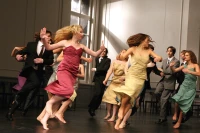This is the third piece by Pina Bausch to enter the Paris Opera's repertoire. After The Rite of Spring in 1997 and Orpheus and Eurydice in 2005, Kontakthof goes a step further by bringing the Opera's dancers face to face with the Tanztheater and the Wuppertal choreographer's signature gestures. A piece created in 1978 that opens with about twenty dancers in a ballroom to a 1930s tango sung in German. This is the beginning of a succession of scenes that will multiply perspectives on conventions, relationships, physical contact, violence, and sexuality. And gradually bring out the mosaic of 1930s German society. It lasts 3 hours, it could last all night. Pina Bausch would reprise it more than 20 years later with dancers over 65 years old, completely amateurs. And 2008 with teenagers from Wuppertal as the transmission of this piece of human history to a new generation. An extraordinary experience that gave rise to the documentary Dancing Dreams: In the Footsteps of Pina Bausch
and the first tour after the choreographer's death.
We remember all this when the dancers of the Paris Opera take the stage of the Opéra Garnier. The contrast is complete between the Kontakthof of the teenagers taking their first steps and that of the virtuoso dancers of the Paris Opera. The technique here is impressively precise, the gestures are perfectly mastered where the teenagers were groping. But the teenagers' Kontakthof was incredibly more lively than the one presented to us by the Paris Opera. The more the piece progresses, the more we realize that this Kontakthof is danced, more than performed. And the choreographic star is extinguished when one of the essential dimensions of Pina Bausch's Tanztheater is missing: the narrative. This is blatant when the men crowd around one of the dancers to turn her into a simple sexual object, without identity, without will, without consent. And when the music stops at the end of the show, the sound of the dancers' rhythmic footsteps no longer has the same violence.


